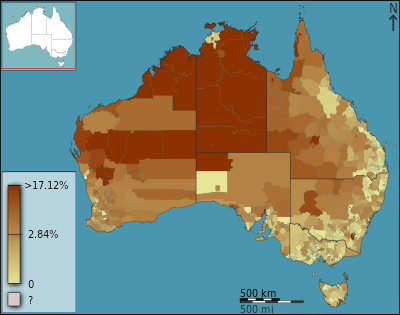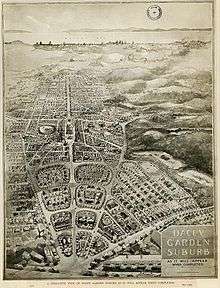Public housing in Australia

Public housing in Australia is provided by departments of state governments. Australian public housing operates within the framework of the Commonwealth-State Housing Agreement, by which funding for public housing is provided by both federal and state governments.[1] According to the 2006 census, Australia's public housing stock consisted of some 304,000 dwellings out of a total housing stock of more than 7.1 million dwellings, or 4.2% of all housing stock[2] (compared with 20% in Denmark, 46% "low rent housing" in France and 50% public housing in the UK at peak)
Construction of new public housing dwellings is currently at its lowest rate for 40 years and existing public housing stock is severely underfunded. There are also moves towards privatisation and transition into "community" and "social" housing models. This has led to recent campaigns to save public housing marked for demolition, advocate for upgrades and maintenance and construction of new public housing dwellings, such as the ongoing Bendigo street housing campaign in which homeless people are being housed by community in homes left empty by the Victorian state government.
Overview

The state government departments which are responsible for providing public housing have been known by a variety of names due to their history in each state, such as the Office of Housing (Victoria), the Department of Housing (Queensland) and Housing SA (formerly known as the Housing Trust, South Australia). Their official name tends to change with the way each state government prioritises public housing within its departmental structure. For example, for a time in the 1980s, Victoria's public housing had its own department (Department of Planning and Housing). Since the early 1990s, departmental restructuring under the Kennett government relegated its status to the 'Office of Housing' within the Department of Planning and Development. It has since been moved from a 'bricks and mortar' issue to one of health and welfare, now being an office within the Department of Human Services. The management of some public housing has been outsourced to not-for-profit management companies as part of a demand management philosophy to target it towards people with special needs.
Dwelling types
Australian public housing has traditionally been of two main types – Inner-city medium to high-rise apartments, and low-density townhouses or fully detached houses on master-planned estates located on, what were at the time of construction, the suburban fringes of cities and towns. The inner-city public housing is mostly found in Melbourne and Sydney on estates generally comprising 3-5 story walk-up flats and 11-22 story high-rise towers. Since the late 1990s, the Victorian government has embarked on a process of redeveloping its inner-city estates with a mix of public and private housing. Low-density suburban estates can be found in nearly every city and town in Australia. Some of the low-density housing has been sold off over the years to long term tenants, and some has begun to circulate on the private property market at high prices in gentrified suburbs such as Port Melbourne.
History
Most public housing in Australia was built between 1945, when the first Commonwealth State Housing Agreement was signed, and 1980, with governments in recent decades less willing to build and provide for new mass public housing estates. The majority of Australia's public housing programs were originally initiated to house returned soldiers and their new families after World War II; a period of chronic housing shortages across the country. However the construction of high-rise estates in Melbourne and Sydney during the 1950s and 1960s was aimed more at improving the living conditions of inner-suburban residents living in sub-standard housing.
During the late 1970s, as local community resistance grew to inner suburban high-rise estates, public housing programs were severely curtailed. In addition to the reaction to large high-rises in the inner city was the social stigmatisation following the creation of sizeable enclaves of a single, negatively perceived socio-economic group. From the 1980s onwards, the focus was on small-scale infill projects and 'spot-purchase' of existing dwellings in appropriate locations.
Social housing
In recent years, not-for-profit social housing providers have developed a more prominent role in providing affordable housing to eligible tenants. These social housing providers include charities, and organisations such as the Brisbane Housing Company, a not-for-profit corporation operated by the Queensland Government and the Brisbane City Council. Co-operation between state housing departments and social housing providers is increasing, as in Queensland where prospective tenants who are on the waiting list for public housing are now also on the waiting list for social housing.[4]
Public housing today
Construction of new public housing dwellings is currently at its lowest rate for 40 years and existing public housing stock is severely underfunded. The public housing waiting list in Victoria for example currently sits at 35,000 and is increasing dramatically. There is a severe lack of new public housing dwellings.
There are also moves towards privatisation and transition into "community" and "social" housing models that create tension between non-government organisations working on housing and homelessness, with some vying for management or ownership of previously state-owned or managed public housing, while other organisations resist privatisation and advocate for the expansion of public housing to alleviate waiting lists and homelessness. There have been a number of recent campaigns to save public housing marked for demolition, advocate for upgrades and maintenance and construction of new public housing dwellings. State governments will occasionally announce funding policies for upgrades and maintenance.
The issue of empty state government-owned homes is increasing as every state has hundreds or thousands of empty homes that could be transferred to public housing registers. In Melbourne, Victoria, this issue has led to the ongoing Bendigo street housing campaign in which homeless people are being housed by community campaigns in homes left empty by the Victorian state government.
Suburbs with public housing
Some suburbs of Australian cities with a high concentration of public housing, with at least 15% of all occupied dwellings recorded as being rented from a state or territory housing authority at the 2006 census, include:
|
Adelaide
Brisbane
Geelong
|
Melbourne
Lake Macquarie
|
Perth Sydney
Wollongong |
See also
- Housing Commission of Victoria
- Housing NSW
- Public housing in the Australian Capital Territory
- Bendigo street housing campaign
- American Radburn design for public housing
Australian housing
References
- ↑ The Reluctant Landlords? - A History of Public Housing in Australia
- ↑ Tenure Type and Landlord Type by Dwelling Structure - 2006 Census results, Australian Bureau of Statistics
- ↑ ABC: Verbatim, retrieved 10 February 2011
- ↑ Queensland Department of Housing, One Social Housing System
- ↑ Community economic development and public housing estates. Shelter NSW. December 2004. p. 26.
External links
State and territory housing departments
- Housing & Community Services ACT
- Housing NSW
- Territory Housing (Northern Territory)
- Queensland Department of Housing
- Housing SA
- Housing Tasmania
- Victorian Office of Housing
- Western Australian Department of Housing & Works